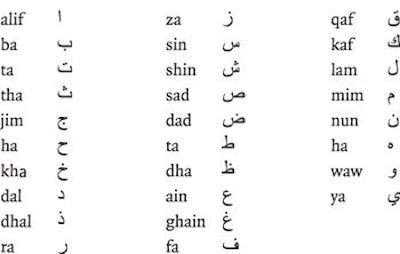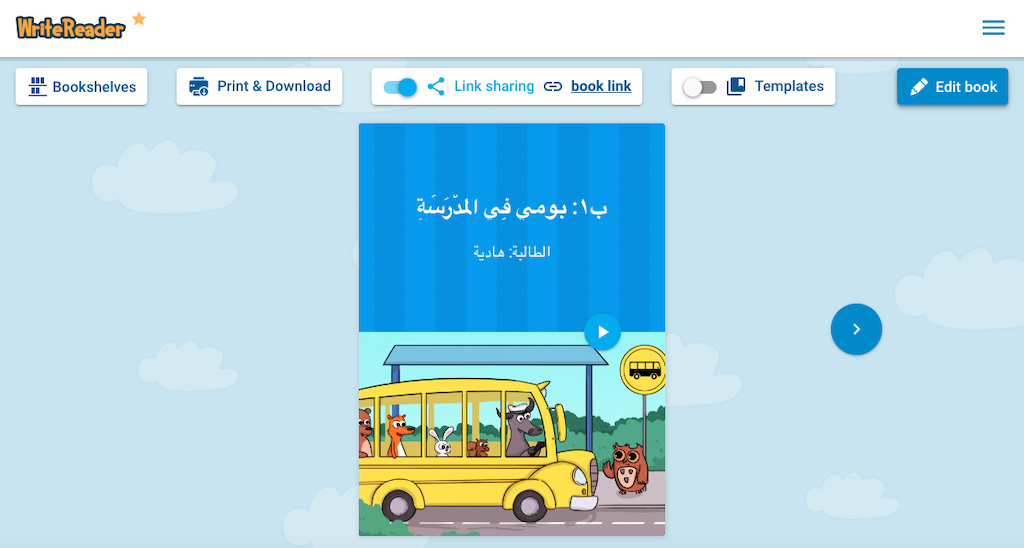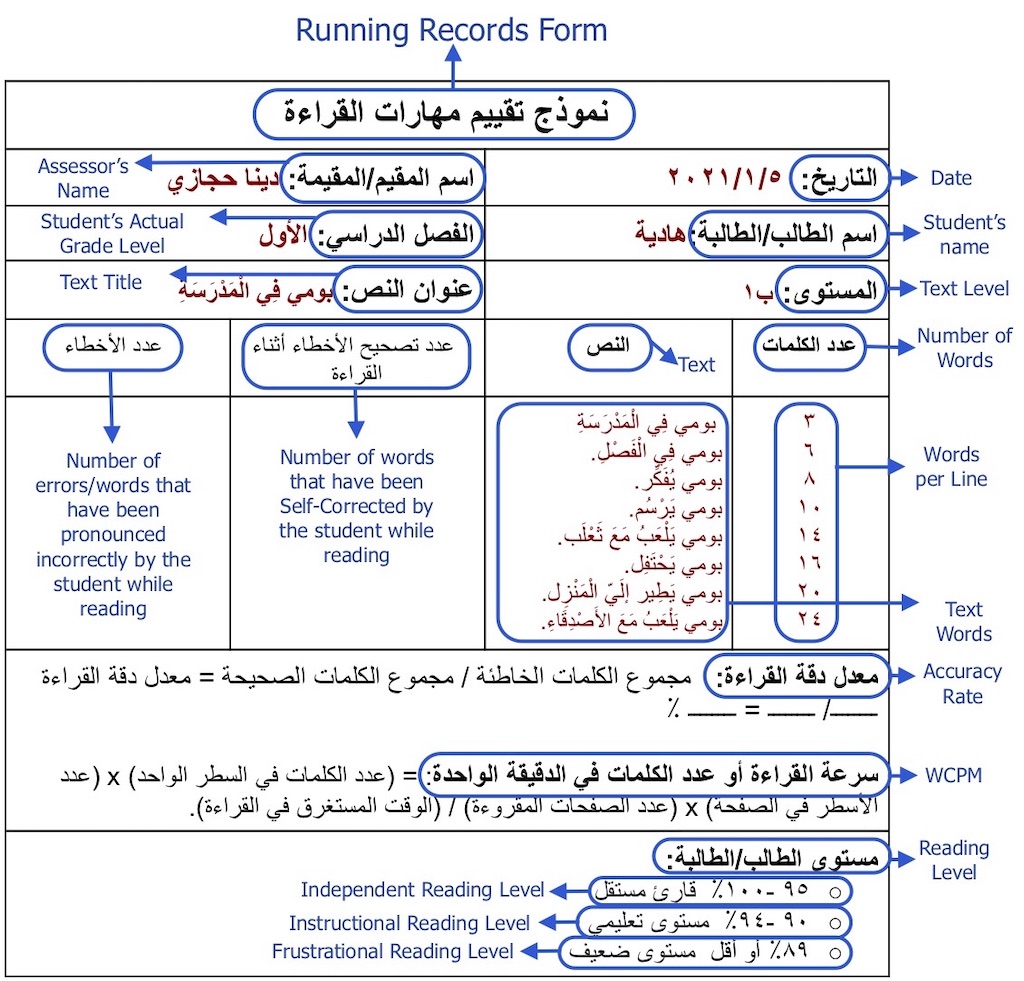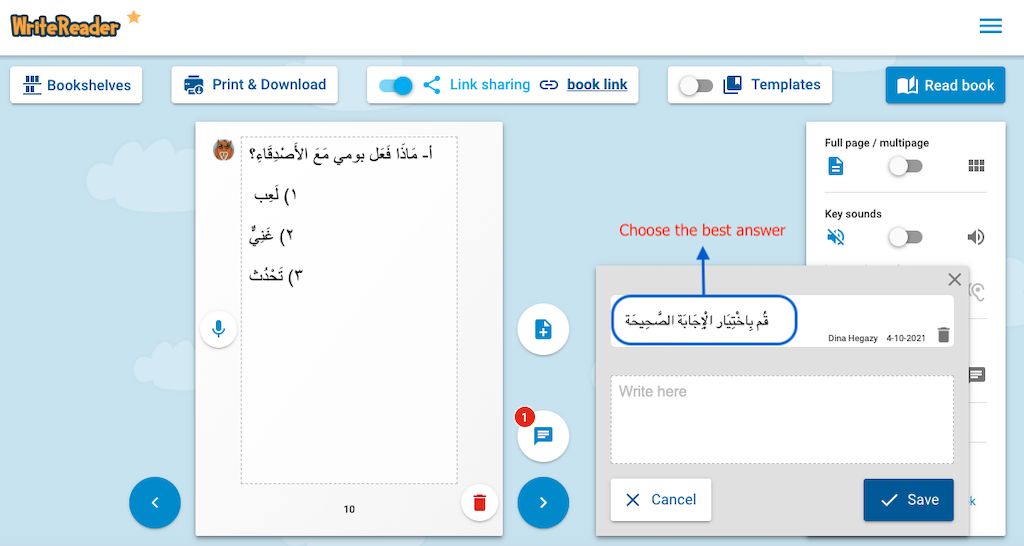By Dina Hegazy, grade 3 homeroom teacher, El Alsson International School, Giza, Egypt
The lack of guided reading platforms, diagnostic and placement tools in Arabic narrows down the opportunities for efficient placement where students would be able to either read within their ZPD: Zone of Proximal Development, or to be placed on their instructional and/or independent reading level during guided or independent work.
The good news is there is a way! Teachers can utilize WriteReader’s features to create Arabic running records and benchmark assessments to know the student’s instructional and/or independent reading level.
Before we start, below is a brief description of Arabic phonology to understand the different dimensions and considerations needed to use and create a placement tool.
Arabic Phonology
The Arabic language consists of 28 letters, all representing consonants is written from right to left, and there is no distinction between upper and lowercase letters. There are two additional consonants that are not part of the alphabet, yet are placed in different positions in the word and do generate varied sounds based on diacritical marks. They are the hamza (ء) and tāĀ marbūTa (ة).

Letters can take a different shape in isolation and as an initial, medial or final sound.

Diacritical marks are added above or below the letters to pronounce words correctly, and here is where vowels exist in the Arabic language; it is through the “tashkeel”; diacritical marks. These marks are called “fat-ha”, “dhamma”, “kasra” and “sukoon”. Changing diacritical marks changes the syntax and semantics of a word.
- Fat-ha is added above the letter, and it generates a short a vowel sound
- Dhamma is added above the letter, and it generates a short u vowel sound
- Kasra is added below the letter, and it generates a short i vowel sound
- Sukoon is added above the letter, and it signals that the consonants have no vowel sounds which sounds like any consonant phoneme in the English language

Additionally, three out of the 28 consonants generate long vowel sounds when no diacritical sounds are added to them:
- The letter “alif” is used in the long vowel aa
- The letter “ya” is used in the long vowel ii
- The letter “waw” is used in the long vowel uu
Creating Arabic Running Records
To create an Arabic running record, the teacher can either select a pre-existing leveled passage; this can include ministry generated anchor texts in grade levels, or create their own. Then, the teacher creates the running record by either
- Uploading the text in a form of an image on WriteReader
- Typing up the passage in Arabic using the diacritical marks on WriteReader
The teacher can carry out the running records face to face with the students using a device at school, or assign it online during remote learning. To measure the student’s oral reading fluency (ORF) level, the student will use the recording feature to record themselves reading the passage, and thus allowing the teacher to mark errors, self-correction, wcpm and accuracy rates on the printed or digital running record document for placement and record keeping.
Creating Arabic Benchmark Assessments
To create the benchmark assessment to assess comprehension, the teacher can add additional pages to the WriteReader book and type specific questions that match the passage either by asking multiple choice questions and/or short questions, and the student will respond in the text box by typing the best answer. Also, the teacher can ask open-ended questions and use a retelling rubric to measure the students’ comprehension skills. To facilitate the process of retelling the text, the student will use the recording feature to answer the open ended questions.
Determining the Readability Level of Arabic Texts
While it isn’t prevalent to locate lexile level charts for Arabic reading level placement, here is a link that could ease the process of determining the readability levels of books in our Arabic libraries: Arabic Thought Foundation Readability Levels.
Example
According to the Arabic Thought Foundation Readability Levels, this WriteReader generated Arabic running record and benchmark assessment book titled بومي فِي الْمَدْرَسَةِ is at the second level out of 4 for a 1st-grade student.

Running Record Form
You can use this template that follows the same structure below:

Comprehension Quiz
Once the student completes recording themselves reading, they can start answering comprehension questions by typing the right answer or recording themselves responding to the questions. The teacher can use the scoring system applied by multiple guided reading programs to assess comprehension and placement as follows:
- Independent Level: 90 % and above
- Instructional Level: 80% to 90%
- Frustrational Level: Less than 80%

References
Augustyn, Adam. Arabic Alphabet. Britannica, Encyclopædia Britannica, Inc.
Enbom, Anna. Arabic Vowels. Learn Arabic, Arabic.fi, 10 Aug. 2020
Origins and Characteristics of the Arabic Alphabet. Metmuseum.org, The Metropolitan Museum of Art
Sarayra, Dina. Vowels in Arabic: Short Vowels. Kaleela, 7 Apr. 2021
المستويات الانقرائية. Taha, H. (2017). The Hanada Taha Arabic Text Leveling System. Publisher: Publisher: Educational Book House Publishing, KSA.
قراءة سريعة.” المعرفة, Marefa,
مؤلف . The Arabic Alphabet: A Guide to the Phonology and Orthography of MSA and Lebanese Arabic. Lebanese Arabic Institute, 3 May 2020
